Bees and Beekeeping
- The hornet has landed: Scientists combat new honeybee killer in USarstechnica.com The hornet has landed: Scientists combat new honeybee killer in US
Researchers are working to limit the threat while developing better eradication methods.
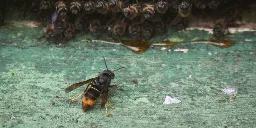
- The Rise Of The Bee Bandits | NOEMAwww.noemamag.com The Rise Of The Bee Bandits | NOEMA
Where once there was cattle and horse rustling, the American West is now confronting the theft of its bees.

- Bumblebees socially learn behaviour too complex to innovate alone - Naturewww.nature.com Bumblebees socially learn behaviour too complex to innovate alone - Nature
Bumblebees can learn how to open a two-step puzzle box by observing another trained bee, indicating that these insects can use social learning to acquire a behaviour too complex to otherwise be learnt through individual trial and error.

- How scientists proved that bees can perceive timegreenrosechemistry.com How scientists proved that bees can perceive time
Did you know that bees can perceive time? Not even just simply tracking the Sun. Actual time measurements.
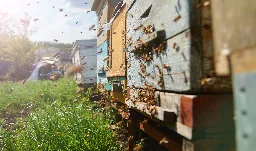
- Wi-Fi harms bees. Do people care about this? Should there be counter actions in the EU?bgr.com Smartphones and Wi-Fi are killing vital insects
An analysis of over 80 studies shows a direct link between mobile phone and Wi-Fi radiation and declining insect populations. Radiation can affect insects at …

cross-posted from: https://sopuli.xyz/post/7625705
> According to the linked article, 72 studies suggest that wi-fi radiation harms/kills #bees -- and by some claims is a threat to their continued existence. I suppose if extinction were really a likely risk there would be widespread outrage and bee conservationists taking actions. It seems there is a lack of chatter about this. This thread also somewhat implies disinterest in even having wi-fi alternatives. > > In any case, does anyone think this is a battle worth fighting? Some possible off-the-cuff actions that come to mind: > * ban the sale of wi-fi devices bigger than a phone in Europe¹ if they do not also comply with these conditions: > * include an ethernet port as well. So e.g. macbooks would either have to bring back the ethernet port or nix wi-fi (and obviously Apple wouldn’t nix Wi-Fi). > * have a physical wi-fi toggle switch on the chassis (like Thinkpads have) > * force public libraries with Wi-Fi to give an ethernet port option so library users at least have the option of turning off their own wi-fi emissions. > * ban the sale of Wi-Fi APs that do not have: > * a configurable variable power setting that is easily tunable by the user; maybe even require a knob or slider on the chassis. > * bluetooth that is internet-capable > * force phones that include wi-fi to also include bluetooth as well as the programming to use bluetooth for internet. Bluetooth routers have existed for over a decade but they are quite rare.. cannot be found in a common electronics shop. > > Regarding bluetooth, it is much slower than wi-fi, lower range, and probably harder to secure. But nonetheless people should have this option for situations where they don’t need wi-fi capability. E.g. when a phone is just sitting idle it could turn off wi-fi and listen over bluetooth for notifications. > > I suspect the 1st part of this quote from the article explains the lack of concern: > > “The subject is uncomfortable for many of us because it interferes with our daily habits and there are powerful economic interests behind mobile communication technology.” > > 1. I say /Europe/ because it’s perhaps the only place where enough people would be concerned and where you also have the greatest chance of passing pro-humanity legislation (no “Citizens United” that human needs have to compete with).
- What it’s like to be a beepress.princeton.edu What it’s like to be a bee
Alien minds are right here, all around you. Indeed, the perceptual world of bees is so distinct from ours, governed by completely different sense organs, and their lives are ruled by such different priorities, that they might be accurately regarded as aliens from inner space.

- 'Inert' ingredients in pesticides may be more toxic to bees than scientists thoughttheconversation.com ‘Inert’ ingredients in pesticides may be more toxic to bees than scientists thought
Inert ingredients are added for purposes other than killing pests and are not required under federal law to be tested for safety or identified on pesticide labels.
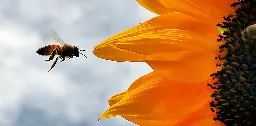
- Conditioning honeybees to a specific mimic odor increases foraging activity on a self-compatible almond variety - Apidologielink.springer.com Conditioning honeybees to a specific mimic odor increases foraging activity on a self-compatible almond variety - Apidologie
Almond is a high-market value crop that benefits from honeybee pollination services, even for self-compatible varieties. Besides, it has been recently shown that the offering of food scented with floral mimic odors specific to different crops biased honeybee foraging preferences towards sunflowers, ...
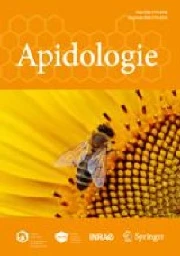
- Honeybees cluster together when it’s cold – but we’ve been completely wrong about whytheconversation.com Honeybees cluster together when it’s cold – but we’ve been completely wrong about why
New research shows honeybee hive clusters are a sign of desperation, not insulation.

- Pesticides, herbicides and fungicides detected in beeswax | Cornell Chroniclenews.cornell.edu Pesticides detected in beeswax | Cornell Chronicle
An analysis of beeswax in managed honeybee hives in New York finds a wide variety of pesticide, herbicide and fungicide residues, exposing current and future generations of bees to long-term toxicity.
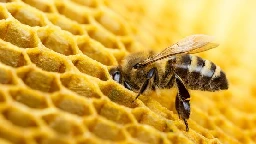
- Citizen scientists in Singapore add needed buzz to bee research in Asiawww.straitstimes.com Citizen scientists in Singapore add needed buzz to bee research in Asia
Bee records shared by citizen scientists have contributed to a better understanding of species’ conservation status. Read more at straitstimes.com.
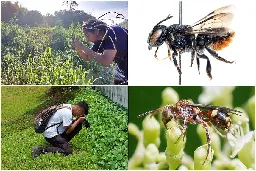
- New centralized pollination portal for better global bee data creates a buzzphys.org New centralized pollination portal for better global bee data creates a buzz
A powerful new way to fill major gaps in public bee data—including from Africa, Asia and other under-reported zones—has been addressed with a centralized tool for consolidating bee pollinator occurrences around the globe.
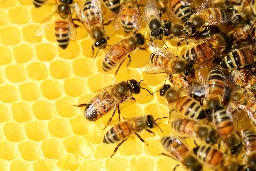
- ‘Bees are sentient’: inside the stunning brains of nature’s hardest workerswww.theguardian.com ‘Bees are sentient’: inside the stunning brains of nature’s hardest workers
‘Fringe’ research suggests the insects that are essential to agriculture have emotions, dreams and even PTSD, raising complex ethical questions

- How bees can monitor pollution for us – everything from toxic metals to antimicrobial resistancetheconversation.com How bees can monitor pollution for us – everything from toxic metals to antimicrobial resistance
Using bees as biomonitors can be a more sensitive and effective way of detecting contaminants than traditional sampling methods, new research shows.

- Is Beekeeping Wrong? Parasites and pesticides have brought chaos to bee colonies throughout the world. Natural beekeepers want to transform our relationship to the hive.www.newyorker.com Is Beekeeping Wrong?
Parasites and pesticides have brought chaos to bee colonies throughout the world. Natural beekeepers want to transform our relationship to the hive.
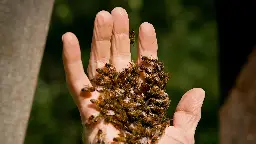
- How geometry solves architectural problems for bees and waspswww.sciencenews.org How geometry solves architectural problems for bees and wasps
Adding five - and seven - sided cells in pairs during nest building helps the colonyfit together differently sized hexa gonal cells , a new study shows.
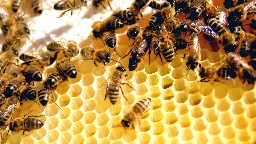
- Little identification help please?

Edit:
Halictus scabiosae, identified through observations.be with 99% certainty.What am I looking at? Except a very industrious little worker?
How do I go about figuring it out? Is there some reliable site that would allow me to refine by stripes and such? Thanks.
This is Wallonia, Belgium. I got a new camera, which allows me to get much more detailed entirely useless pictures! I was one with the bees for an entire hour, came home with 500 pictures, and this is the only photo I got of this one. The stripe pattern struck me, with the very sharp lines, but I have no head, no thorax, no nothing...
- Where do honey bees come from? New study 'turns the standard picture on its head'www.livescience.com Where do honey bees come from? New study 'turns the standard picture on its head'
DNA analysis indicates the world's most common bee originated in northern Europe around 780,000 years ago, before spreading into East Africa and Arabia around 120,000 years later.

- Kamon Reynolds no longer affiliated with Hive Life conference, and now planning a separate conferencem.youtube.com Kamon Reynolds Conference Update !!! BIG NEWS
Kamon & Laurel Reynolds have helped to spearhead the greatest beekeeping movement of our time. The community, collaborations & friendships that have blossome...

What do folks make of this news? I know a lot of U.S. (and some Canadian) beekeepers have really enjoyed the Hive Life conference in the past.
- Honey bees more faithful to their flower patches than bumble bees, new study showsphys.org Honey bees more faithful to their flower patches than bumble bees, new study shows
Honey bees are more faithful to their flower patches than bumble bees when it comes to returning to collect more pollen and nectar, according to a study by U.S. Department of Agriculture, Agricultural Research Service scientists.
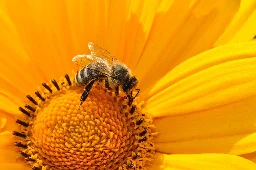
- How the Tech Behind a COVID-19 Vaccine is Helping Save Beestime.com How the Tech Behind a COVID-19 Vaccine is Helping Save Bees
A biotechnology startup has developed a revolutionary new treatment for bee disease that could have wide applications for agriculture.
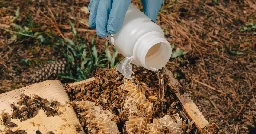
- Pollinator Interaction Databases
Hey folks, I found a few Pollinator Databases to share and would appreciate any more interaction databases or reference you guys use being thrown my way. :)
Global Bee Interaction Dataset
- https://github.com/seltmann/global-bee-interaction-data >This dataset comprises all bee interactions indexed by Global Biotic Interactions (GloBI; Poelen et al. 2014). It is published quarterly by the Big Bee Project (Seltmann et al. 2021) to summarize all available knowledge about bee interactions from natural history collection, and community science observations (i.e., iNaturalist), and the literature. Interactions include flower visitation, parasitic interactions (mite, viral), lecty, and many others.
UK DoPI - UK Database of Pollenator Interactions
- https://www.sussex.ac.uk/lifesci/ebe/dopi/ >The Database of Pollinator Interactions (DoPI) documents British pollinator-plant associations. DoPI unites the disparate publications currently scattered throughout the scientific literature with unpublished reports and databases into a single online depository.
- AP News: 48% of US honey bee colonies died last yearapnews.com Nearly half of US honeybee colonies died last year. Struggling beekeepers stabilize population
A new survey says America's honeybee hives just staggered through the second highest death rate on record, with beekeepers losing nearly half of their managed colonies.
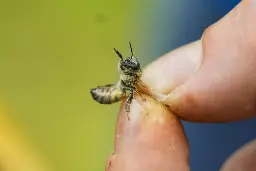
This article has been circulating for a while, summarizing the latest BIP data on colony losses. Thought this forum might allow some beekeeper discussion of it. Do we think this annual "doom and gloom" reporting on BIP's colony loss survey data is useful, or does it sow pointless confusion among non-beekeepers?
- Carpenter bee visiting my Passionflower

Hi all, this little guy (or maybe big for a bee) was visiting my Passionflower today :)
- Adoption of meliponiculture in the domestic United States
Hello all,
With the threat of honeybee extinction looming on the horizon, I got to thinking that rearing stingless bees could eventually supplant apiculture for the production of high-value base materials used in the biomedical industry. Unfortunately, they don't produce much in the way of actual honey and the slow (re-)adoption of the practice has coincided with the loss of traditional knowledge and habitat destruction in Mesoamerica.
Despite many efforts to fund research programs around the world, interest in adopting meliponiculture here in North America seems next to nil. Perhaps there is a good reason behind it, but I suspect it's merely the product of ignorance and lack of funding sources.
With that said, has anyone heard or read anything that suggests the potential for (safely and lawfully) importing these little beauties into North America? Even if you don't know, I would love to hear everyone's thoughts and musings on meliponine bees anyways.
- Welcome! Are all subscribers here beekeepers? If so, whereabouts?
Or do you hope to keep bees? Or just think bees are neat?
- Caging queens to fight varroa - useful technique or needless sacrifice of productivity?www.betterbee.com Using a Frame Isolation Cage in Varroa Management | Betterbee
How to use a frame isolation cage to induce a brood break
This article was published recently and it seems like the method described could be useful or may just interrupt broodrearing so much that a colony wouldn't ever be able to thrive after being subjected to it. Who has tried any queen caging method like this before? Did it work for you?

